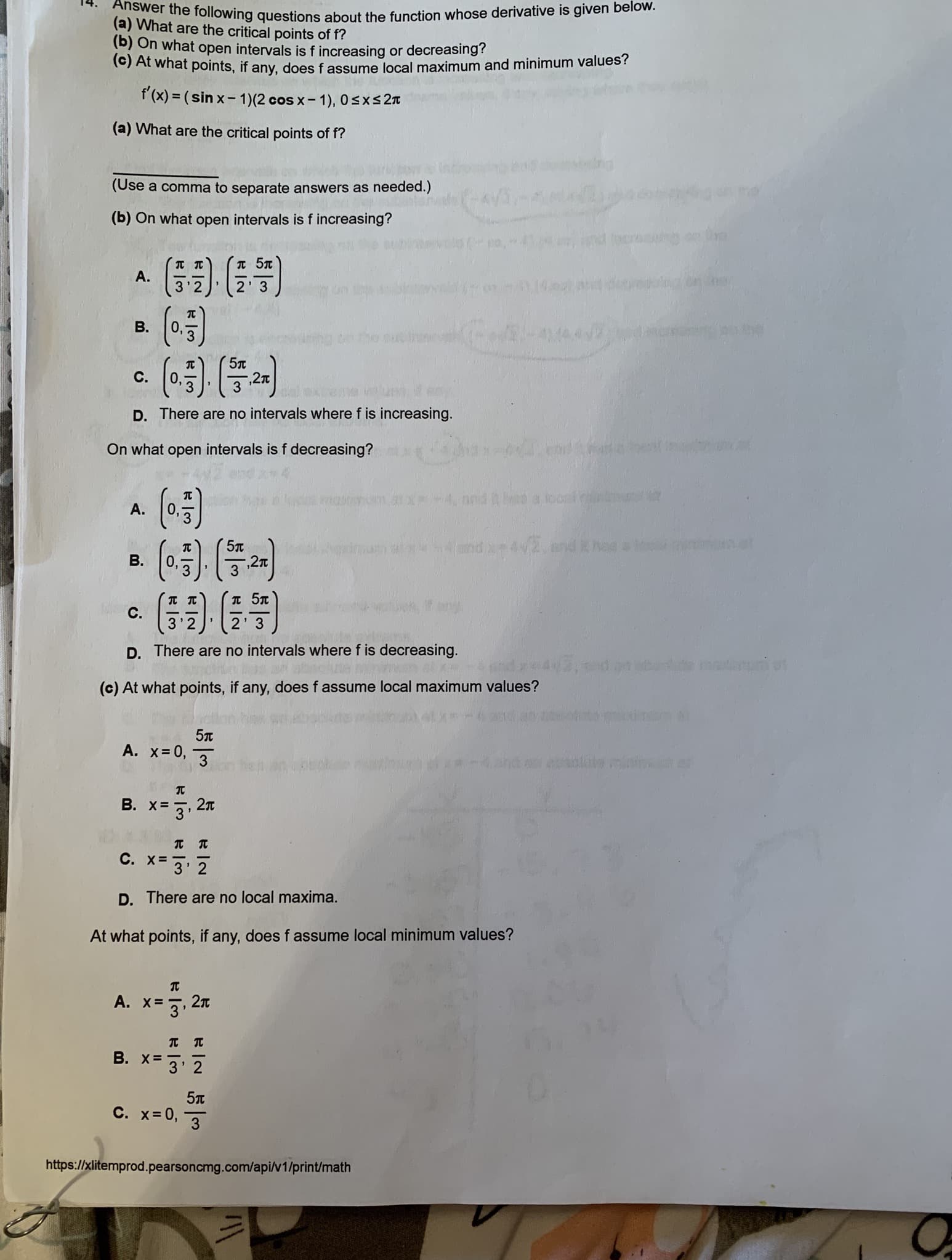Answer the following questions about the function whose derivative is given below. (a) What are the critical points of f? () On what open intervals is f increasing or decreasing? (0) At what points, if any, does f assume local maximum and minimum values? f'(x) = ( sin x- 1)(2 cos x- 1), 0sxs2T (a) What are the critical points of f? (Use a comma to separate answers as needed.) (b) On what open intervals is f increasing? T 5n A. 2 3 B. the su C. ,2n D. There are no intervals where f is increasing. On what open intervals is f decreasing? (5) () =) and Ae a loo A. **4/2.endkhees net B. п 5л C. 3'2 D. There are no intervals where f is decreasing. (c) At what points, if any, does f assume local maximum values? 5T A. x=0, 3 В. X%3D, 2т 3' C. x=7. 3' 2 D. There are no local maxima. At what points, if any, does f assume local minimum values? A. x=D , 2π 3' B. X= 3' 2 C. x= 0, 3 https://xlitemprod.pearsoncmg.com/api/v1/print/math
Answer the following questions about the function whose derivative is given below. (a) What are the critical points of f? () On what open intervals is f increasing or decreasing? (0) At what points, if any, does f assume local maximum and minimum values? f'(x) = ( sin x- 1)(2 cos x- 1), 0sxs2T (a) What are the critical points of f? (Use a comma to separate answers as needed.) (b) On what open intervals is f increasing? T 5n A. 2 3 B. the su C. ,2n D. There are no intervals where f is increasing. On what open intervals is f decreasing? (5) () =) and Ae a loo A. **4/2.endkhees net B. п 5л C. 3'2 D. There are no intervals where f is decreasing. (c) At what points, if any, does f assume local maximum values? 5T A. x=0, 3 В. X%3D, 2т 3' C. x=7. 3' 2 D. There are no local maxima. At what points, if any, does f assume local minimum values? A. x=D , 2π 3' B. X= 3' 2 C. x= 0, 3 https://xlitemprod.pearsoncmg.com/api/v1/print/math
Trigonometry (MindTap Course List)
10th Edition
ISBN:9781337278461
Author:Ron Larson
Publisher:Ron Larson
ChapterP: Prerequisites
SectionP.6: Analyzing Graphs Of Functions
Problem 6ECP: Find the average rates of change of f(x)=x2+2x (a) from x1=3 to x2=2 and (b) from x1=2 to x2=0.
Related questions
Question

Transcribed Image Text:Answer the following questions about the function whose derivative is given below.
(a) What are the critical points of f?
() On what open intervals is f increasing or decreasing?
(0) At what points, if any, does f assume local maximum and minimum values?
f'(x) = ( sin x- 1)(2 cos x- 1), 0sxs2T
(a) What are the critical points of f?
(Use a comma to separate answers as needed.)
(b) On what open intervals is f increasing?
T 5n
A.
2 3
B.
the su
C.
,2n
D. There are no intervals where f is increasing.
On what open intervals is f decreasing?
(5)
() =)
and Ae a loo
A.
**4/2.endkhees
net
B.
п 5л
C.
3'2
D. There are no intervals where f is decreasing.
(c) At what points, if any, does f assume local maximum values?
5T
A. x=0,
3
В. X%3D, 2т
3'
C. x=7.
3' 2
D. There are no local maxima.
At what points, if any, does f assume local minimum values?
A. x=D , 2π
3'
B. X=
3' 2
C. x= 0,
3
https://xlitemprod.pearsoncmg.com/api/v1/print/math
Expert Solution
This question has been solved!
Explore an expertly crafted, step-by-step solution for a thorough understanding of key concepts.
This is a popular solution!
Trending now
This is a popular solution!
Step by step
Solved in 2 steps with 4 images

Recommended textbooks for you

Trigonometry (MindTap Course List)
Trigonometry
ISBN:
9781337278461
Author:
Ron Larson
Publisher:
Cengage Learning

Trigonometry (MindTap Course List)
Trigonometry
ISBN:
9781337278461
Author:
Ron Larson
Publisher:
Cengage Learning